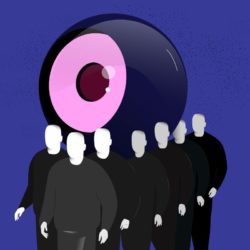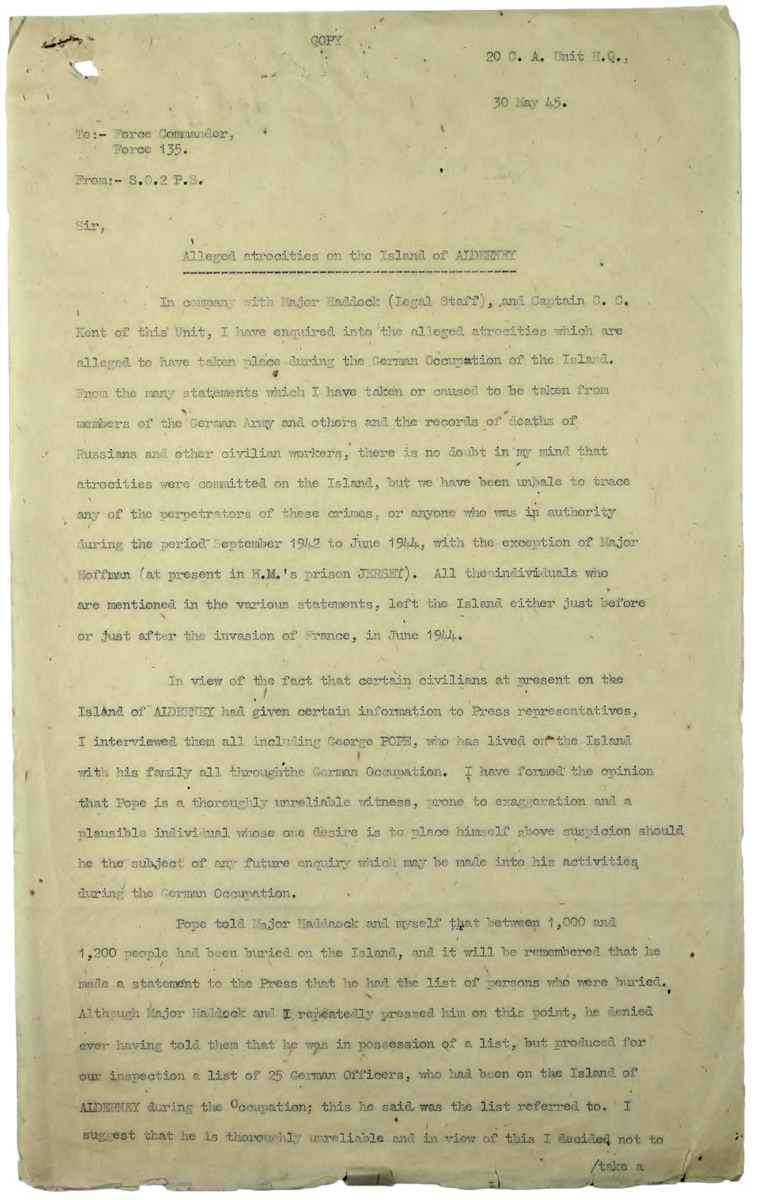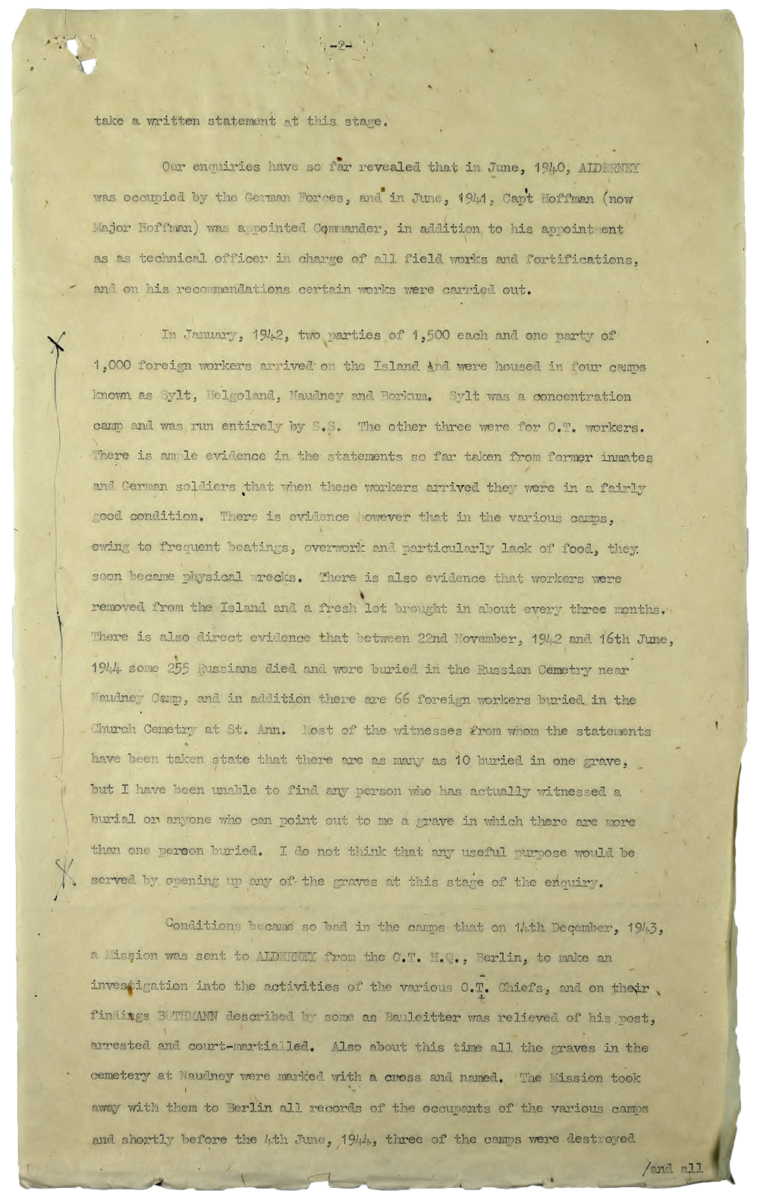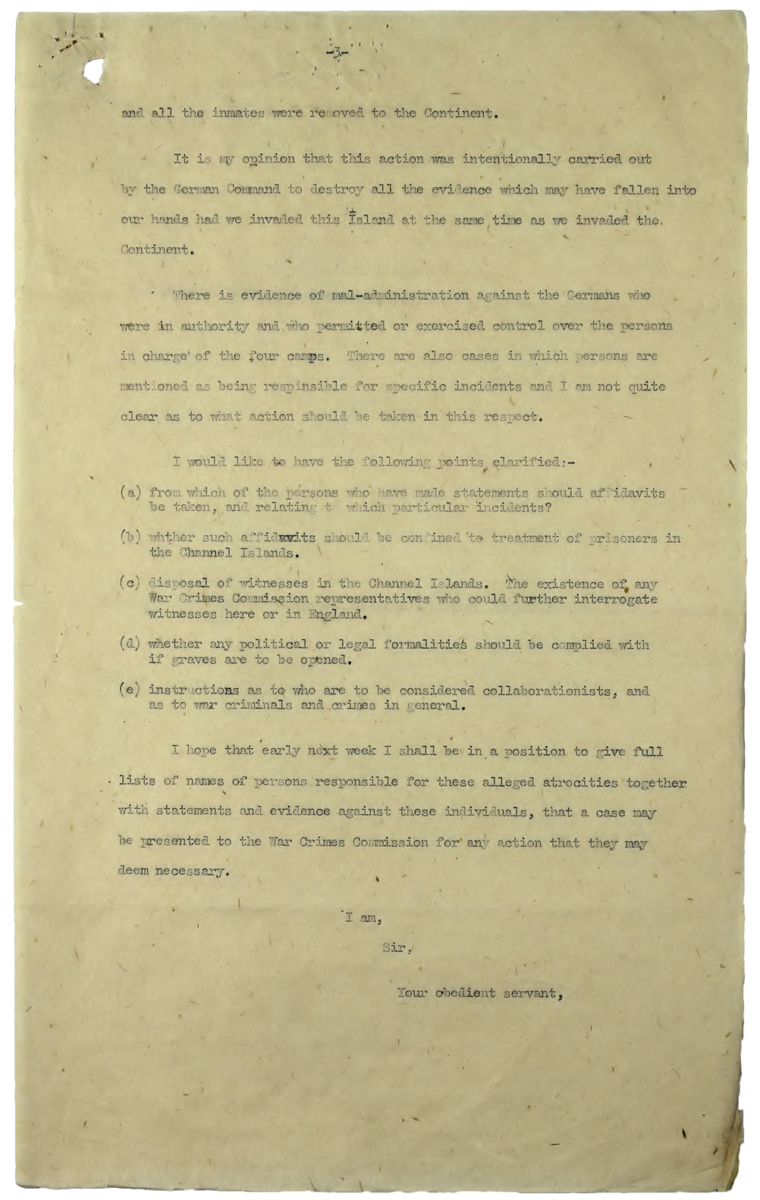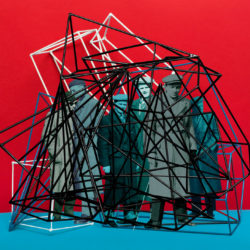
Channel Islands
The Channel Islands were the only piece of British territory Germany ever managed to occupy during the Second World War.

Alderney itself was such a prized strategic possession, it was nicknamed “Adolf Island.”
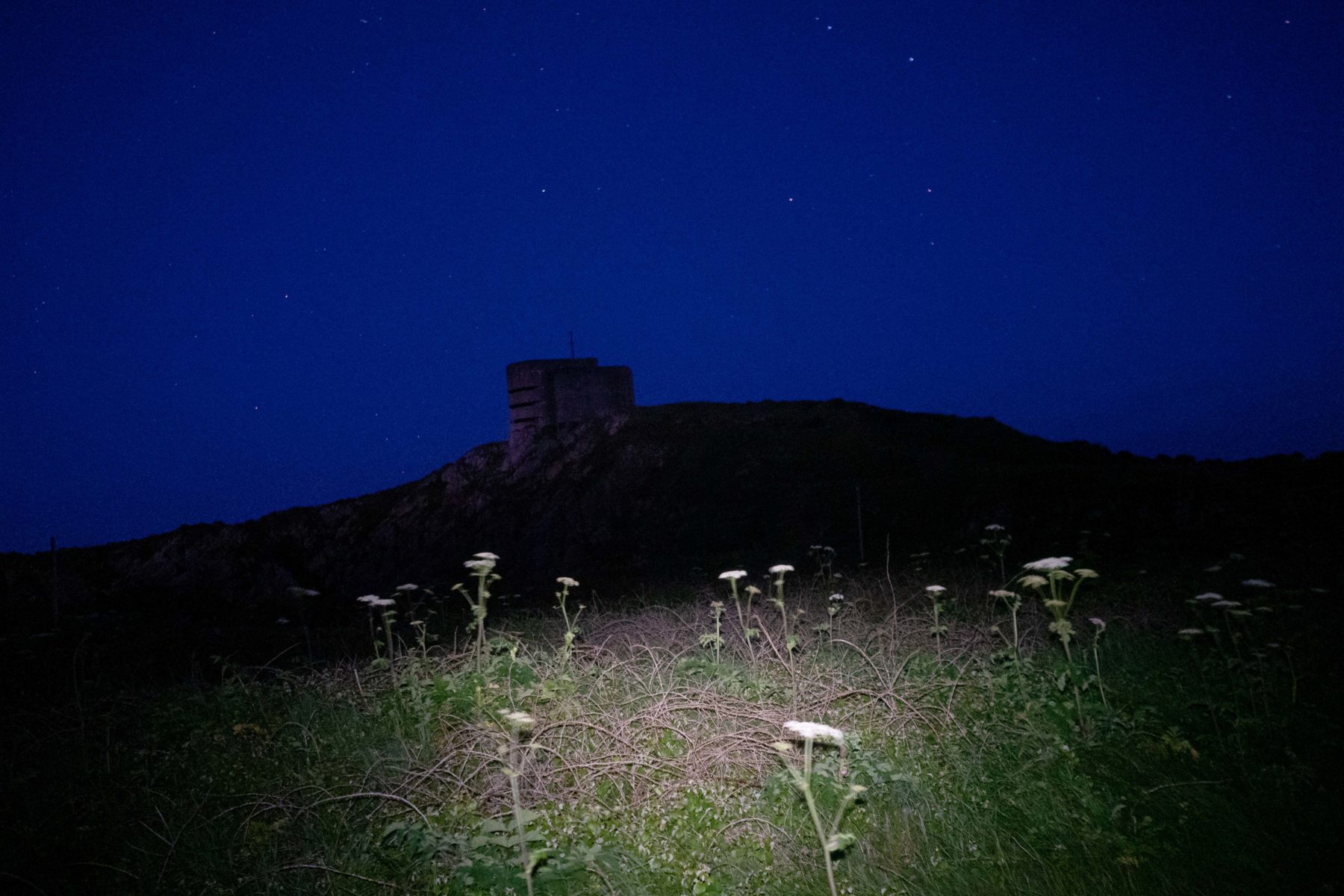
On this deserted island, the Germans left a fingerprint of the Holocaust: SS concentration camps run on U.K. soil.

Today, residents are finally asking: Why has the British government done nothing, when it has evidence of German war crimes on its soil?
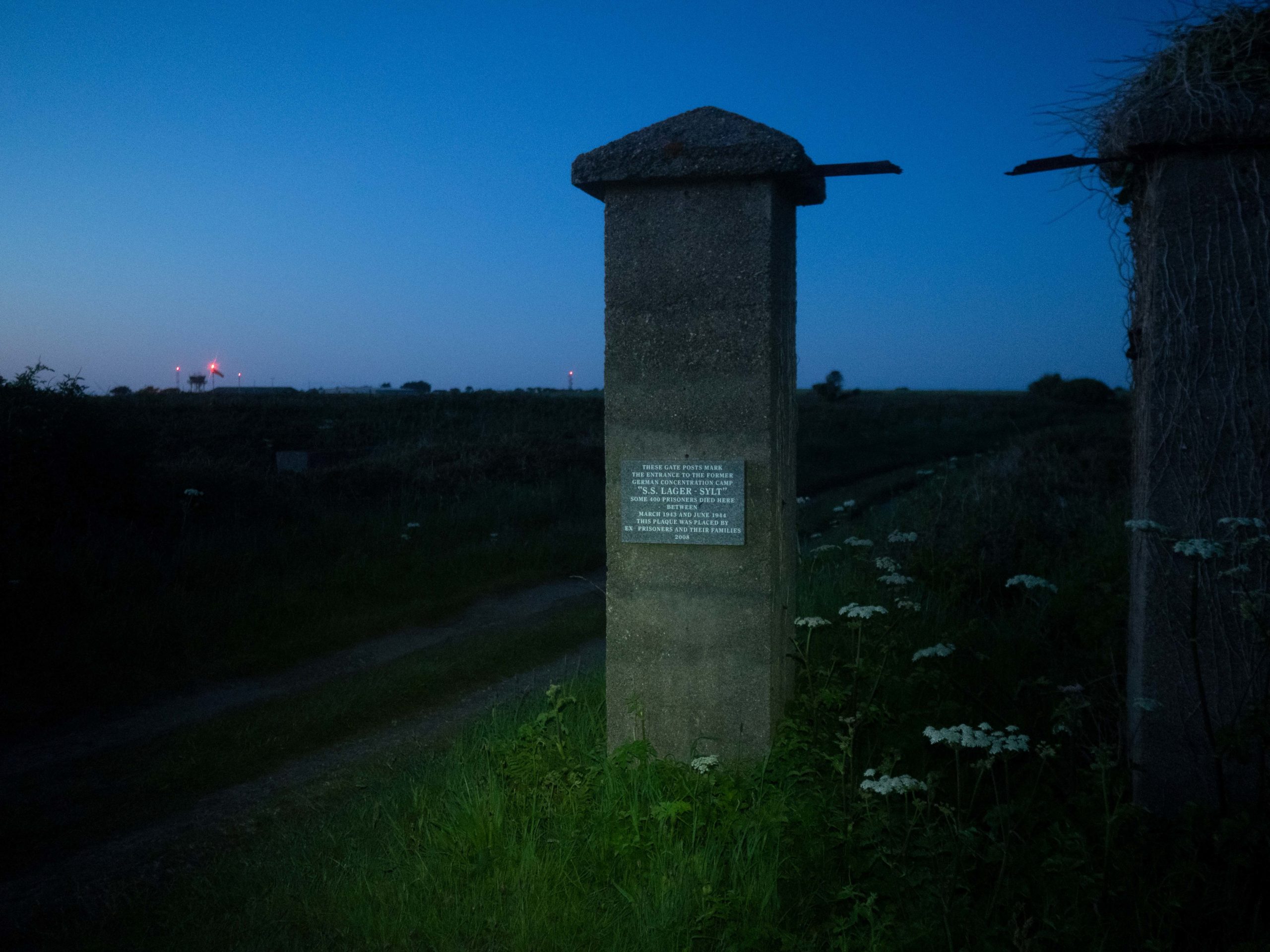
The Nazi concentration camps on British soil the UK government tried to forget
- By Isobel Cockerell
- Photography by Thomas Dworzak/Magnum Photos
- feature
Most years, when the Channel Islanders of Alderney come together on May 22 to memorialize the victims of the Nazi occupation, it rains. A chilly wind whips up from the sea as a congregation gathers to pay tribute to the thousands of people who toiled and died in forced labor camps on this tiny island.
But today, it’s bright and clear.
Fluttering above us, with the sea and the sky beyond, is a blue-and-white striped flag. It represents the uniforms of the prisoners. There are plaques in Russian, Hebrew, French, Polish and Spanish to commemorate the victims of the German occupation of this island in the English Channel between 1940 and 1945. The Channel Islands, an archipelago belonging to the British Crown, were the only piece of British territory Adolf Hitler managed to conquer during the Second World War. And on Alderney, the Nazis built a series of labor camps — including two concentration camps run by the SS.
The Big Idea: Battling history
Governments rewrite history to further their political goals. School boards insist on rewritten history textbooks to elevate elite groups or privilege favored narratives. But unsavory motives are only one aspect of the rewriting history project. Other impulses are noble, idealistic, and sincere.
All are significant and will impact our politics, international relations, social understandings, economic arrangements. This project will look at specific battles over history — but it’s never really about history.
It’s always a fight over the present.
In the U.K., this story is far from common knowledge, confined to the obscure recesses of the British collective memory. Even when I ask other Channel Islanders from the nearby island of Jersey if they knew Nazi camps existed on British soil, they’re hazy on the details.
In recent months, the British Home Secretary Priti Patel declared the government’s plan to transfer asylum seekers arriving in the U.K. on small boats to detention centers in Rwanda. But before this policy was introduced, Alderney was floated by a right-wing think tank as a possible destination for detainees. “Its location and topography make it suitable in many respects,” the report read, before noting that the island was “gravely misused during World War II by the Nazis.” The think tank’s authors added that while the difficulty of the island’s tiny airfield might be overcome, “the problem of bad associations may be less tractable.”
The suggestion was quickly squashed — perhaps, some islanders thought, because international attention on Alderney would open an enormous Pandora’s box.
Now, as a £100million ($120 million) Holocaust Memorial is planned to be built next to the Parliament building in London, there’s a fight underway over precisely what happened in Alderney, and how Britain should face up to the Nazi atrocities that occured on its territory.
When the British began their investigations on the island after the war it gradually dawned on them that the scale of atrocities could warrant full-scale war crimes trials. As this realization took hold, there was a shift in the tone of the investigations, says Professor Caroline Sturdy Colls, a forensic archaeologist at Staffordshire University who has studied the island for more than a decade. The official narrative changed, skating over the fact that 27 different nationalities were thought to have been brought to the island, among them hundreds of French Jews. Instead, the Foreign Office simply said that “for practical purposes Russians may be considered to be the only occupants of these camps.”
“That enabled the British authorities to hand over the investigation to the Soviets. And that meant they could wash their hands of the whole cost and everything else of war crimes trials,” said Sturdy Colls. It was cleaner and easier to say the prisoners were Russian, and the Soviet Union’s responsibility. The enduring legacy of that decision was that the stories of other prisoners — Jews, other Europeans, North Africans — were largely erased from the official history of Alderney.
At the service, the self-governed island’s President, William Tate, hit back at those who said the island of Alderney was not facing up to its past. “There are those who say that we don’t do enough. I take issue with that. I think we all live with the responsibility of ensuring that the lives of those people that were lost during that period do not go unremarked.”
Alderney is a three-mile-long slither of land that is home to some 2,000 people. Wildly beautiful, surrounded by the seething, white-crested Atlantic, the island is fringed with sandy crescent-shaped beaches. Alderney’s capital, St. Anne, a postcard-perfect, cobbled town, is covered in banners to mark Queen Elizabeth’s Platinum Jubilee when I visit. Though it’s just ten miles off the coast of France, this is unmistakably British soil.
Unlike the other islands of Jersey, Guernsey and Sark, where British residents lived under German occupation, the people of Alderney collectively decided to evacuate their homes in June 1940, when the fall of France was imminent. They did not return until December 1945. On this virtually deserted island –– a mere handful of islanders remained –– the German occupiers acted with impunity, building labor camps and SS-run concentration camps.
The camps operated under the system of “Vernichtung durch Arbeit” — extermination through hard labor — and hundreds, if not thousands of prisoners died here. They were worked to death, forced to build a vast network of fortifications as part Adolf Hiter’s “Atlantic Wall,” a system of defenses along the coast of continental Europe designed to deter allied invasion. The Channel Islands were a key part of this defense structure and Alderney was such a prized strategic possession, it was nicknamed “Adolf Island.”
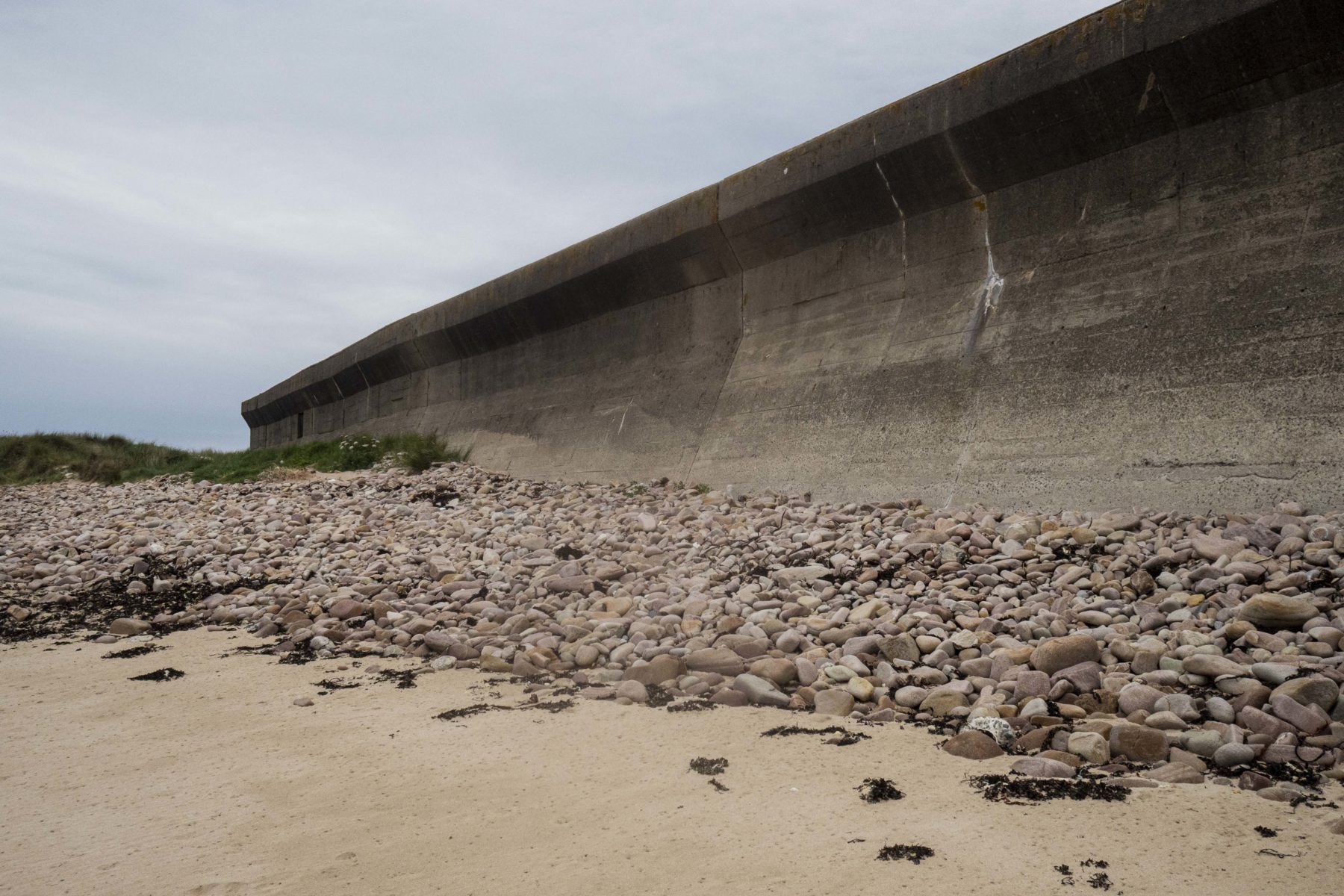
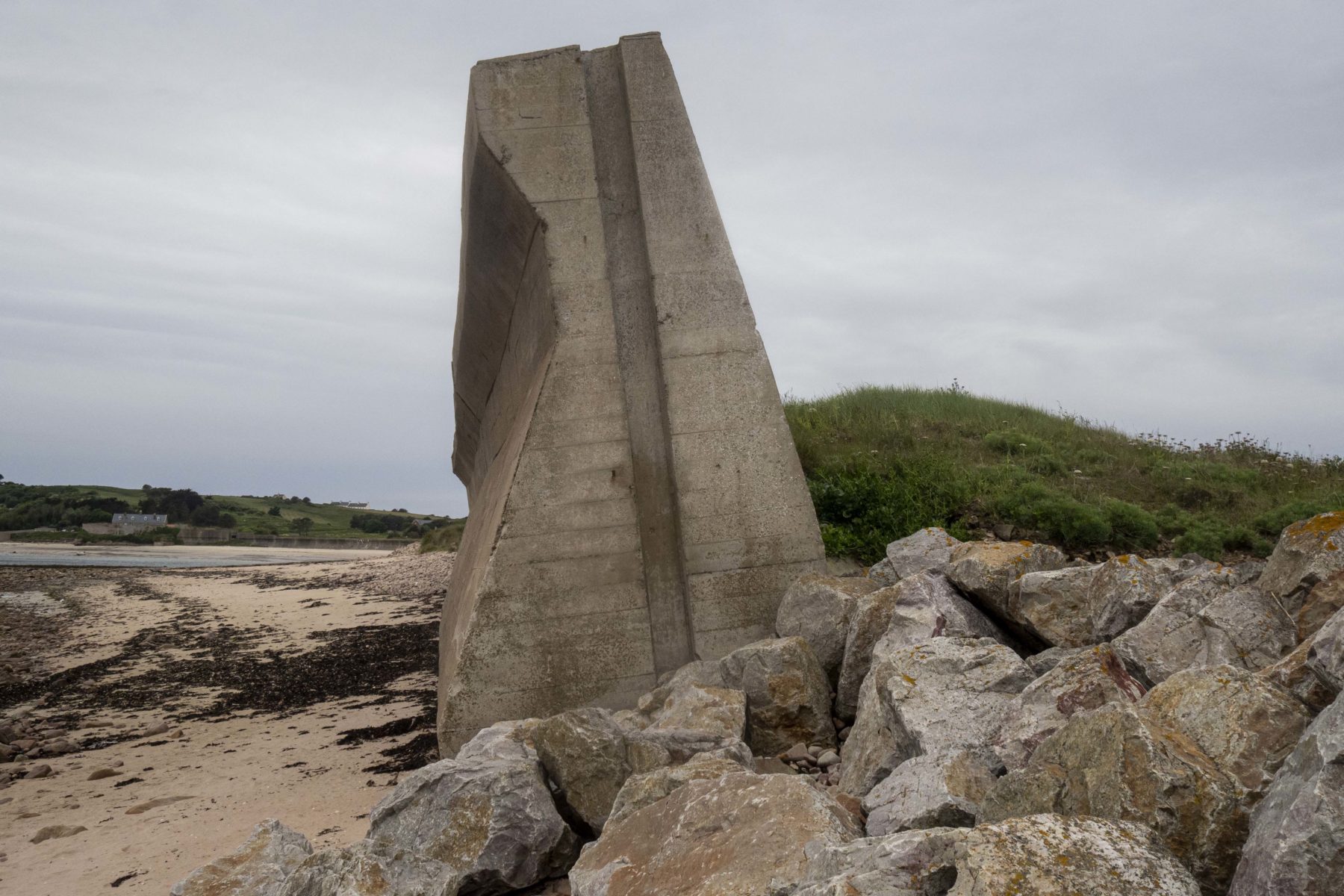
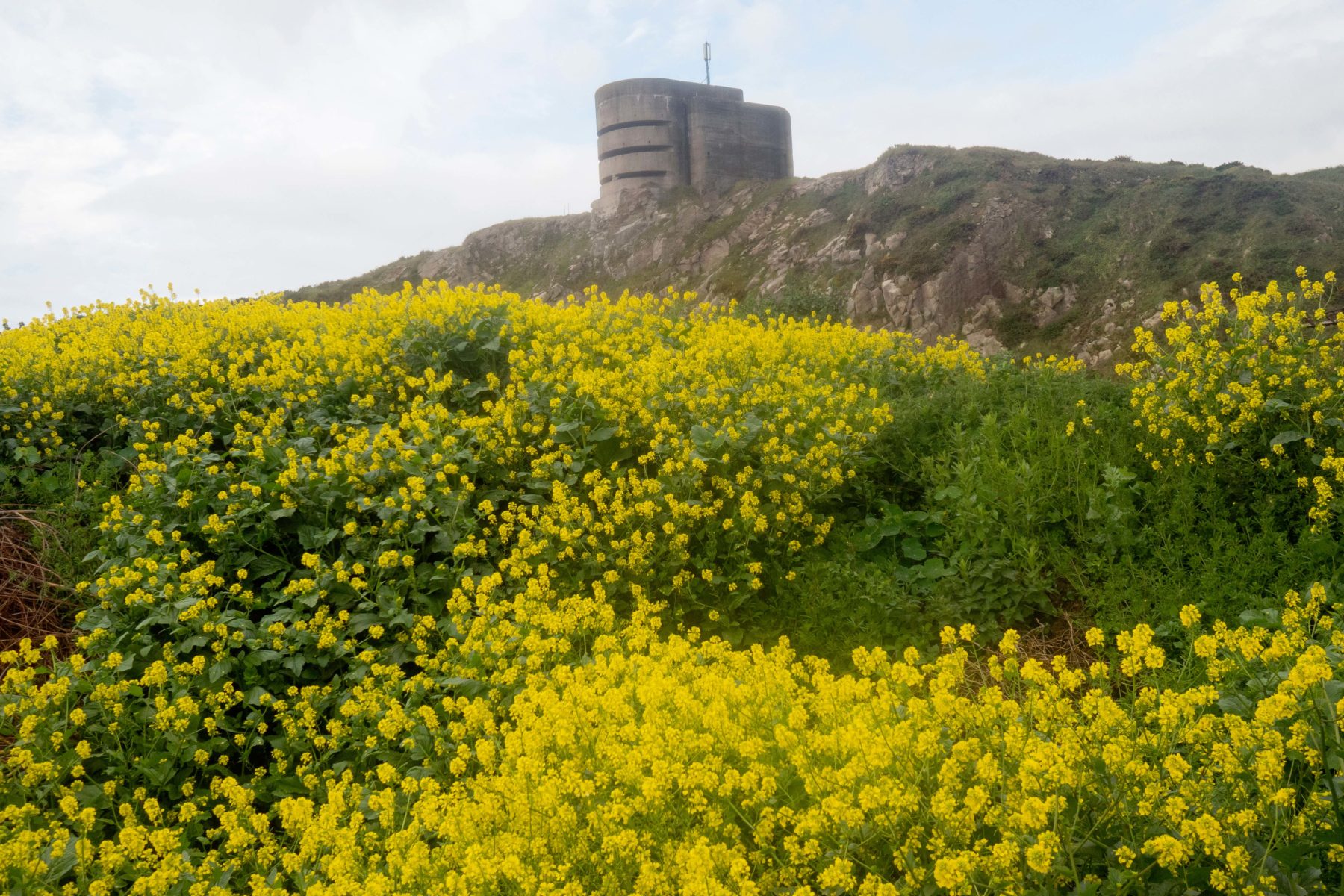
Eighty years later, and the island is still disfigured by concrete bunkers, firing ranges, batteries, and cement fortifications — relics of the darkest chapter of Alderney’s history. Threading through the rock deep below the island, a vast network of tunnels have been gouged out by forced laborers.
What precisely happened here, how many died here, and how they should be remembered are subjects of fierce contention. The British government has been accused of covering up Nazi atrocities on its own soil, of refusing to face up to or reconcile with the horrors of Alderney’s past and keeping it a secret for decades.
“How can Britain, in good conscience, build a £100 million memorial and education center, and become head of the International Holocaust Remembrance Alliance in 2024, if we can’t come clean about one little fingertip of the Holocaust on British soil?” said Michael James, a local resident who was in attendance at the remembrance service. “It’s just wrong. It reeks.”
James believes the number of people who died in Alderney during the war is well into the thousands. “It’s staggering that we’re having to fight to get the truth. If you had died here wouldn’t you want your children to know you had died here? How many hundreds of relatives are out there that don’t know their family members died on this island?”
The islanders were told that there were four camps on Alderney. That slave laborers had worked here and built the island’s fortifications. That these laborers were Russian. That 337 of them had died. But recent studies have identified as many as nine camps and that alongside the Russian prisoners, there were also Europeans, North Africans and Jews.
In contrast to the official number of 337, the highest estimates for the number of deaths on Alderney run to 70,000. Many islanders believe the real number is somewhere in the thousands rather than the hundreds.

When the people of Alderney returned to their island after the war, they said the birds didn’t sing. The island was covered with barbed wire and concrete, and the silence suggested that something terrible had happened. The islanders were told little and asked few questions. Children knew that the gravesites were where “slave laborers were buried.” But, said Sally Bohan, who returned to Alderney after the war as an infant, she didn’t truly absorb what that meant until her late teens. “We didn’t realize the severity and — just the awfulness of it. And there was nothing here to say what had happened.”
People relied on hearsay. Witness testimonies were routinely recounted of bodies being tipped off the breakwater, of people dying while building a vast anti-tank wall running along one of the island’s pristine beaches, their bodies simply folded into the cement. Islanders talked about finding bones on the beaches. About seeing ghosts: juddering forms dressed in the forced laborers’ distinctive striped uniform, up by Lager Sylt, the S.S. concentration camp near where the airport is now located.
John Dalmau, a Spanish forced laborer who was taken to Alderney by the Nazis after fleeing Franco's regime, recounted being sent down as a diver in Alderney's Braye Bay to disentangle an anti-submarine net.
"Among the rocks and seaweed there were skeletons all over the place. Crabs and lobsters were having a feast on the bodies which remained intact," he wrote in the years after his release. "I watched the blown-up bodies moving with the tide."
Talk of a cover up by the British government has been rife on the island for many decades. A question has always hung in the air. Why did the British government let evidence of German war crimes on its soil — the concentration camps and those who suffered in them — remain in obscurity? Why was no one prosecuted?
Different islanders have different answers. Because Britain had other things to be getting on with — a country to rebuild. Because the atrocities weren’t significant enough to require Nuremberg-style trials. Because no one wanted to reflect on how much cooperation there was by Channel Islanders in German crimes. Because there was a collective sense of shame about letting the Channel Islands fall into enemy hands. Because no government wanted talk of Jewish murders on its soil.
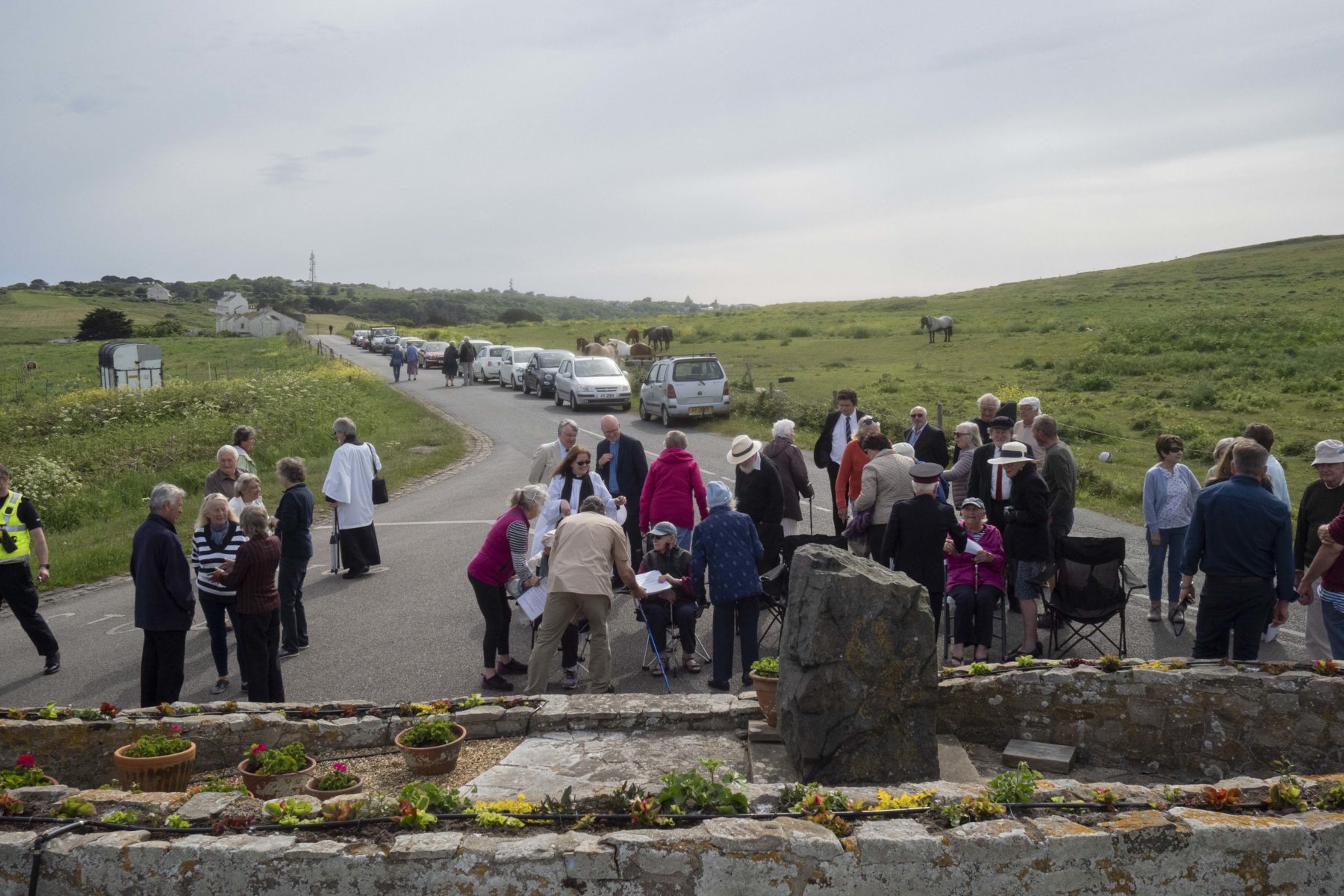
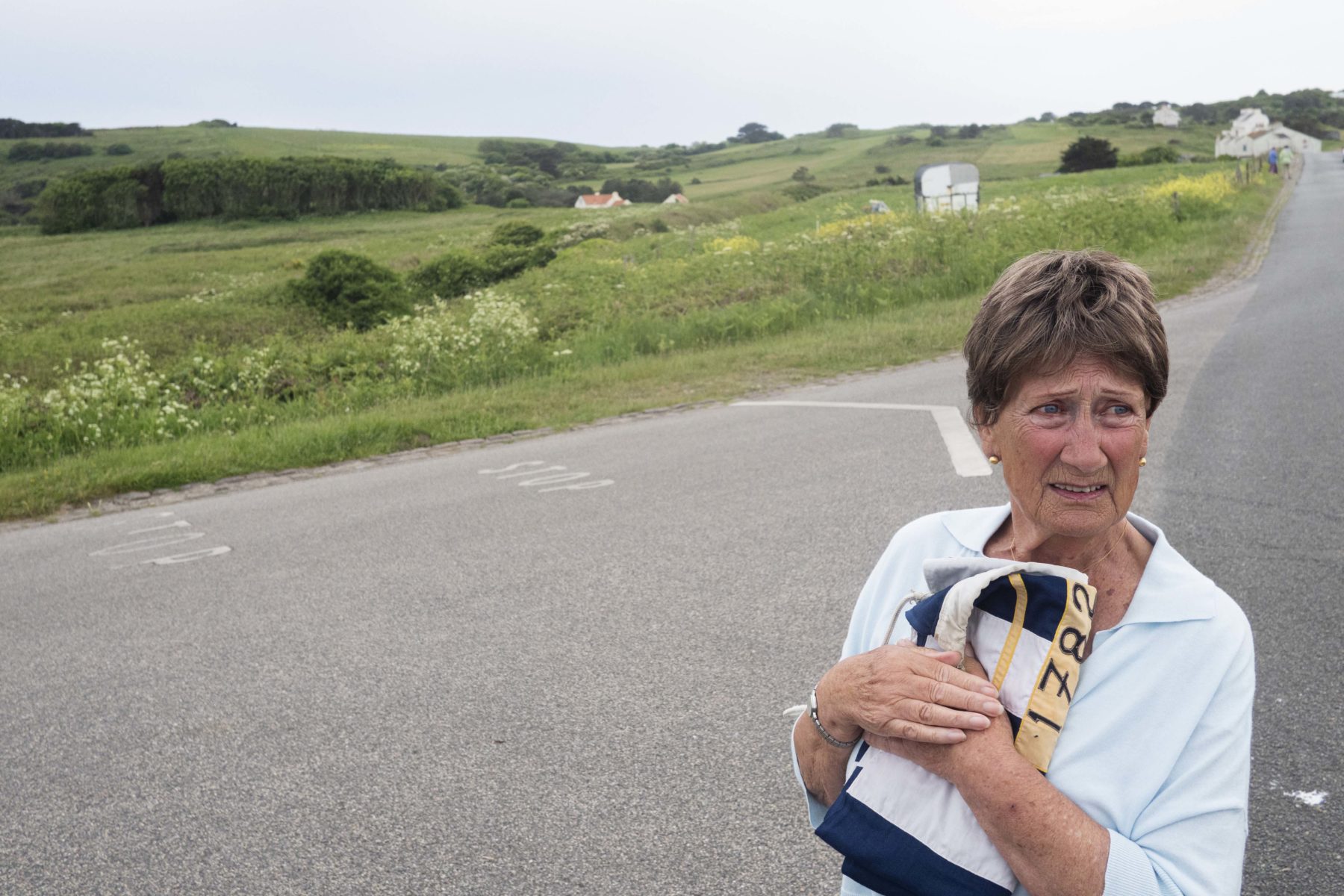
In 2016, when the then-Prime Minister David Cameron announced that a Holocaust Memorial would be built in London’s iconic Victoria Tower Gardens on the banks of the Thames, right next to the Houses of Parliament, he described it “as a permanent statement of our values as a nation.”
At the outset of the Ukraine crisis, U.K. politicians praised the country’s “long, proud history of welcoming refugees.” A government cabinet minister, Tom Pursglove, cited the British 1930s “Kindertransport” policy as an example, when almost 10,000 unaccompanied Jewish children were brought to Britain in the lead-up to World War II. At London’s Liverpool Street Station, a bronze statue of Jewish children arriving with their luggage silently watches over commuters.
The story of the Kindertransport is widely taught as part of the British school history curriculum. But few ask why only children — “kinder” — were given sanctuary, why their parents were left to be murdered by the Nazis.
“The thing is, if we reveal that the Holocaust happened on Alderney, and that quite a number of Jews died there, and that the government covered it up and prevented French Jews in particular getting justice, then where does it leave our program of teaching British values through the Holocaust?” said Marcus Roberts, founder of an Anglo-Jewish heritage organization called Jtrails, who has been studying the German occupation of Alderney for over a decade.
In a fiery meeting in Alderney last July, Lord Eric Pickles, Head of the UK Delegation of the International Holocaust Remembrance Alliance, said the time had come for Britain to face up to its history during the Holocaust, “warts and all.” Following a presentation by the Alliance, laying out proposals for how Alderney could better safeguard the memory of the camps and grave sites dotted around the island, Lord Pickles told Alderney residents that they needed to face up to what had happened on their land.
“We can’t pretend everything was just rosy,” he said. “This is about telling the truth, the unvarnished truth, not for the titillation of others, but because you own it. It’s yours. You didn’t ask to be the custodians of the most important Holocaust site in the British Isles. It’s not what you asked. But you are the custodians and we want to support you.” The Holocaust Remembrance Alliance’s eight recommendations included tasks like improving the mapping, signage and listing of the camp sites and grave areas.
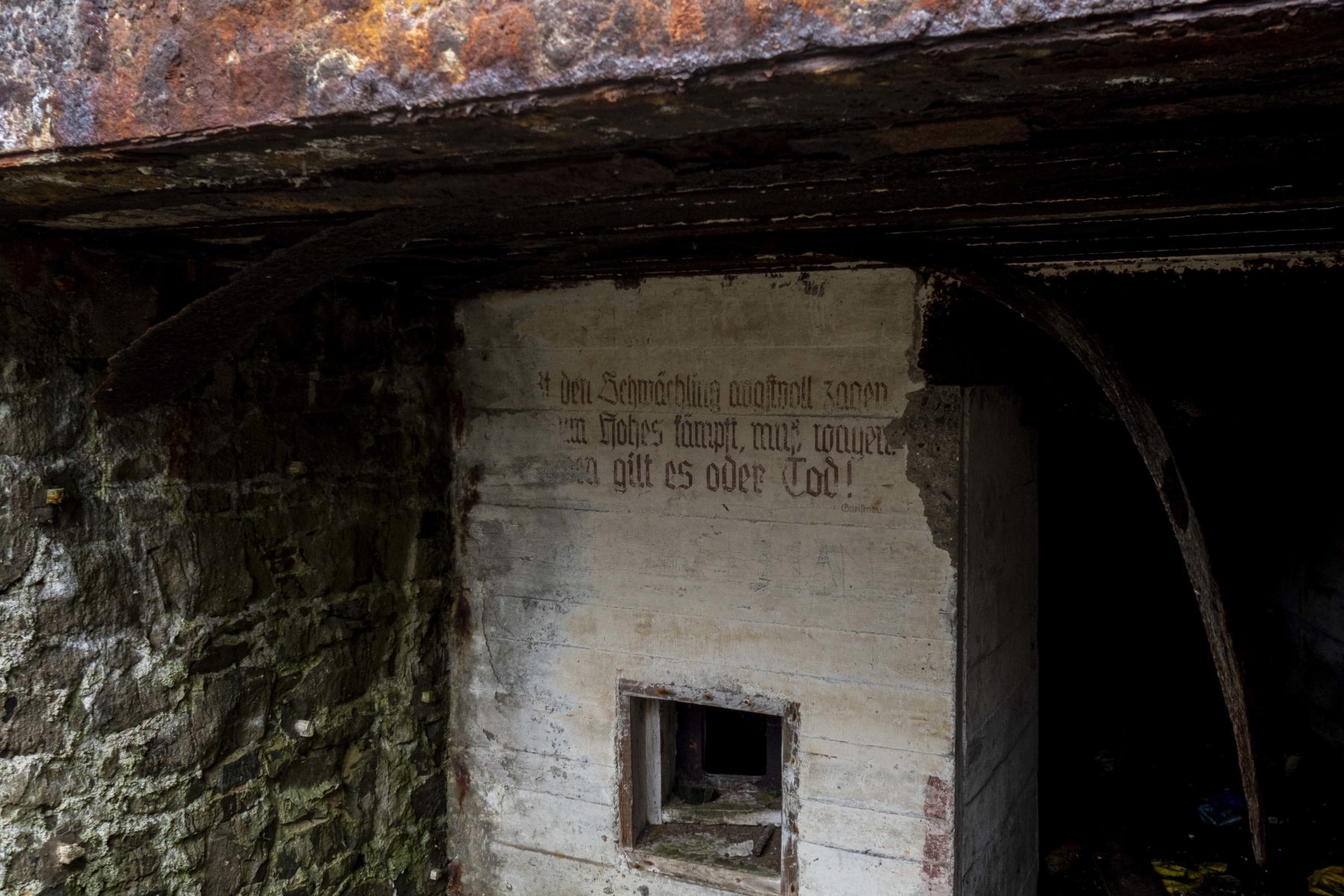
The first person to stand up was Susan Allen, 77, a retired Alderney resident who had worked for the British Foreign Office for several decades. “I’m appalled by all this,” she said. “You are talking about taking over the whole island and turning it into a Holocaust — almost a Disneyland. And I’m sorry, I don’t go along with that.”
Another resident, a former Alderney politician named James Dent, said the memorialization should not be principally focused on Jewish memory. “In Alderney the prisoners were of all faith and no faith,” he said, echoing Allen’s concern that the island shouldn’t become “some macabre theme park for Holocaust tourists.”
Pickles seemed struck by the virulence of the opposition he faced at the town hall. “We’re merely suggesting there should be some small stones, just to be able to give an approximate idea of where things are,” he said a half hour into the impassioned meeting. When I spoke to him on a call last month, he said that he understood why people didn’t want their paradise tainted even by “merely improving the signage.”
“If you move to paradise, you want to see it in those terms. And I don’t think we should look down our noses at people who move to this lovely place that they’ve chosen to live in, and they don’t want to engage in its darker secrets,” he said. “Maybe I’m a little bit too tolerant by nature,” he added, after a pause.
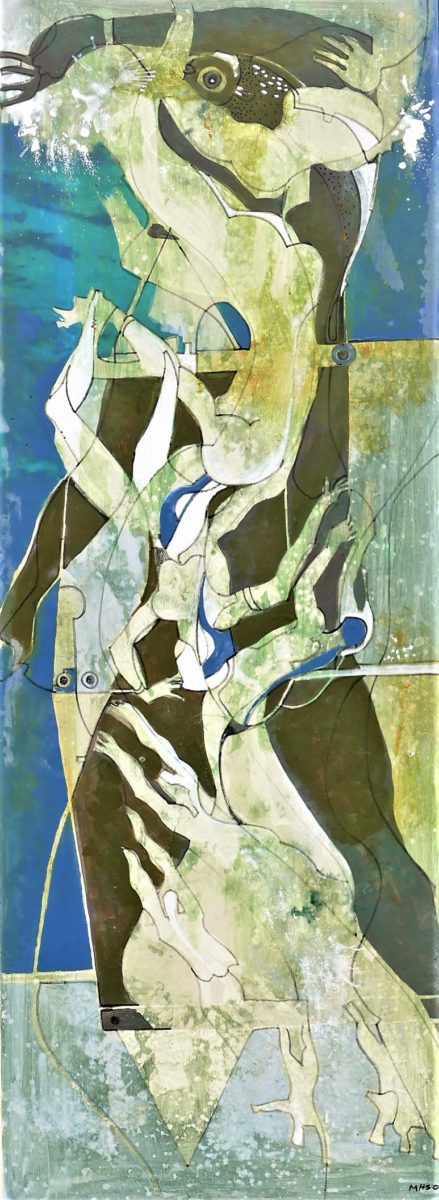
During the town hall meeting, Dr. Gilly Carr, a Cambridge archeologist with a specialism in Holocaust heritage, suggested that the stones could simply have QR codes on them, rather than any text, so that people could find out more information about the gravesites and concentration camp remains only if they wanted to. “The beauty of an online site,” she told the Alderney residents, “is that it’s invisible.”
A spokesperson for the States of Alderney, Alistair Forrest, said the Alliance's suggestions were currently being worked through. “We pay our respect to those who suffered and died in the slave camps on our beautiful Island,” he said.
A debate over the number of people who died in Alderney has soured. “We seem to have become engaged in what I think is possibly a slightly bizarre competition,” Dent, the former politician, said during the meeting, describing how people were constantly trying to “top” each other by quoting ever-larger death tolls. “It doesn’t matter if it was 400, or 4,000, or 40,000 people who died here,” he said, adding that the victims should be memorialized “quietly, and with dignity.”
Knowing just how many died on their island, believe others on Alderney, is essential. The official number of 337 was arrived at back in the 1940s, when Britain commissioned an investigation into atrocities on the island in the aftermath of the war.
In May 1945, after Britain had taken back the island from the German occupiers, Captain Theodore “Bunny” Pantcheff was dispatched to Alderney to conduct an investigation on behalf of British intelligence. The young captain was just 24 at the time, but not inexperienced. He had been a star investigator at the London Cage, British intelligence’s secret interrogation facility during the war years. He was fluent in both German and French and — a bonus — had vacationed on Alderney as a child.
Pantcheff canvassed the experiences of some 3,000 witnesses. He produced a harrowing report, detailing what had happened at Alderney’s various concentration camps.“Crimes of a systematically callous and brutal nature were carried out — on British soil — in the past three years,” he wrote at the outset of the report, before detailing how forced laborers were tortured, starved, and worked to death.
"Workers were beaten for the most trivial offences against the harsh regulations, such as failure to execute a drill movement properly or endeavouring to acquire food from the garbage pail. On occasions workers were beaten for no reason at all."
Theodore Pantcheff, 1945
By counting the number of graves on the island, Pantcheff stated that he knew for certain that 337 people had died there, admitting that “it is impossible to say with any exactitude that the general figure of 337 could represent the full number of deaths on the island.” Pantcheff, his sons explained, was looking for bodies so that prosecutions could be made.
But no prosecutions were ever made –– an outcome that still haunts this island. Instead, the British government packaged up Pantcheff’s report, and sent it over to the Soviet Union, to, as Sturdy Colls put it, “wash their hands of it.” But as British-Soviet relations broke down in the postwar years, the chances of the two governments cooperating and sharing war crimes witnesses began to dwindle, and trials became an impossibility.
In 1947, the French War Crimes authorities requested a copy of the investigation. The British said it “was found that the majority of internees were Russians” and that the reports had been handed over to the Soviet Union. “I regret that the only information we can give you on this matter is the general statement that the Russians were treated with great cruelty,” the British letter to the French authorities read. The letter neglected to mention that held alongside Russian, Polish and Ukrainian prisoners, as well as German, Spanish, and North African inmates, were hundreds of French Jews.
Bunny Pantcheff’s report remained a secret for decades.
His son, Andrew Pantcheff, 67, said his father had dearly wanted to see those guilty of crimes against humanity on Alderney brought to justice. “Even if it’s only one,” Pantcheff pleaded to his higher-ups, according to his son. “Even if it’s only one, so that somebody who tries to do this again won’t be entirely sure that they can just walk away.”
Perhaps the most important prosecution that never happened was that of Major Carl Hoffman, the brutal, relentless commandant in charge of coralling forced laborers into building the island’s massive fortifications.
After the war, the story ran that Hoffman had been hanged in Kyiv in 1945. But in reality, he walked free. He was held in British custody until 1948 before he was allowed to return to Germany, where he lived out the rest of his life, dying peacefully in Hamburg in 1974. It was not until the 1980s that the British Foreign Office admitted this.
In the early 1980s, Solomon H. Steckoll, a South African journalist, attempted his own investigation. “A mass of obstacles had been placed in the path of the truth,” he wrote in his book, “The Alderney Death Camp,” published in 1982. “For over three decades now,” Steckoll wrote, “the silence has rested like a heavy blanket of impenetrable fog over what took place on Alderney.”
Pantcheff wrote his own account of what happened, titled “Alderney, Fortress Island,” published ahead of Steckoll’s book, setting out “to put flesh on the concrete skeleton and try to breathe life into it.”
The blurb reads: “There was no extermination camp, no Auschwitz, nor any ‘cover up.’” In the book, Pantcheff describes how he wants to dispel speculation: “If it does nothing else, at least it may help some of the more fantastic ghosts so far raised — for example the stories of gas-ovens in the concentration camp or bodies thrown in the cement mixer.”
But the book also criticizes those who “shirk the concept of blame or feel that it all happened a long time ago and is no business of theirs. If this book has a purpose, it is to make it as hard as possible to follow any of those easy options.”
According to his sons, Pantcheff hoped to lay bare the catastrophe that had happened on Alderney, and tell the stories of those who toiled and lost their lives there. “It might have been a very small tragedy compared to Auschwitz,” his younger son Richard Pantcheff, 63, said. “But it was a tragedy nonetheless. It was appalling. He didn't want it to be sensationalized. And he didn't want it to be minimized.”
“Alderney, Fortress Island” was the first time Pantcheff’s own account of what had happened on the island was put before the public.
For many years, the official British government line ran that the U.K. copy of the original Pantcheff report had been destroyed to create “shelf space.” Many of Pantcheff’s papers were kept in the Alderney Museum files until the early 2000s, when MI6, the British intelligence agency, requested the files back, according to the museum director Trevor Davenport. “I personally bagged them up and sent them off,” Davenport said, adding that MI6 promised to send back copies. “When we sent them, I said to the council — ‘we’ll never see them again.’ And of course we haven’t.” Davenport said MI6 simply sent back a summary.
In the late 2000s, many of the materials from Pantcheff’s report became accessible at the British Archives. There are, however, files that are not included in the papers –– particularly the full statement by George Pope, one of the only islanders who remained in Alderney during the occupation. Pope said he had seen almost 1,800 Ukrainians die, and witnessed as many as 400 Jews thrown into mass graves. His account was regarded as unreliable by Pantcheff, who suspected Pope of collaborating with the Germans. “The Pope testimony could be the key document,” said Alderney resident Michael James.

The sheer number and size of the fortifications built in Alderney between 1940 and 1945, some argue, make the official death tally dubious.
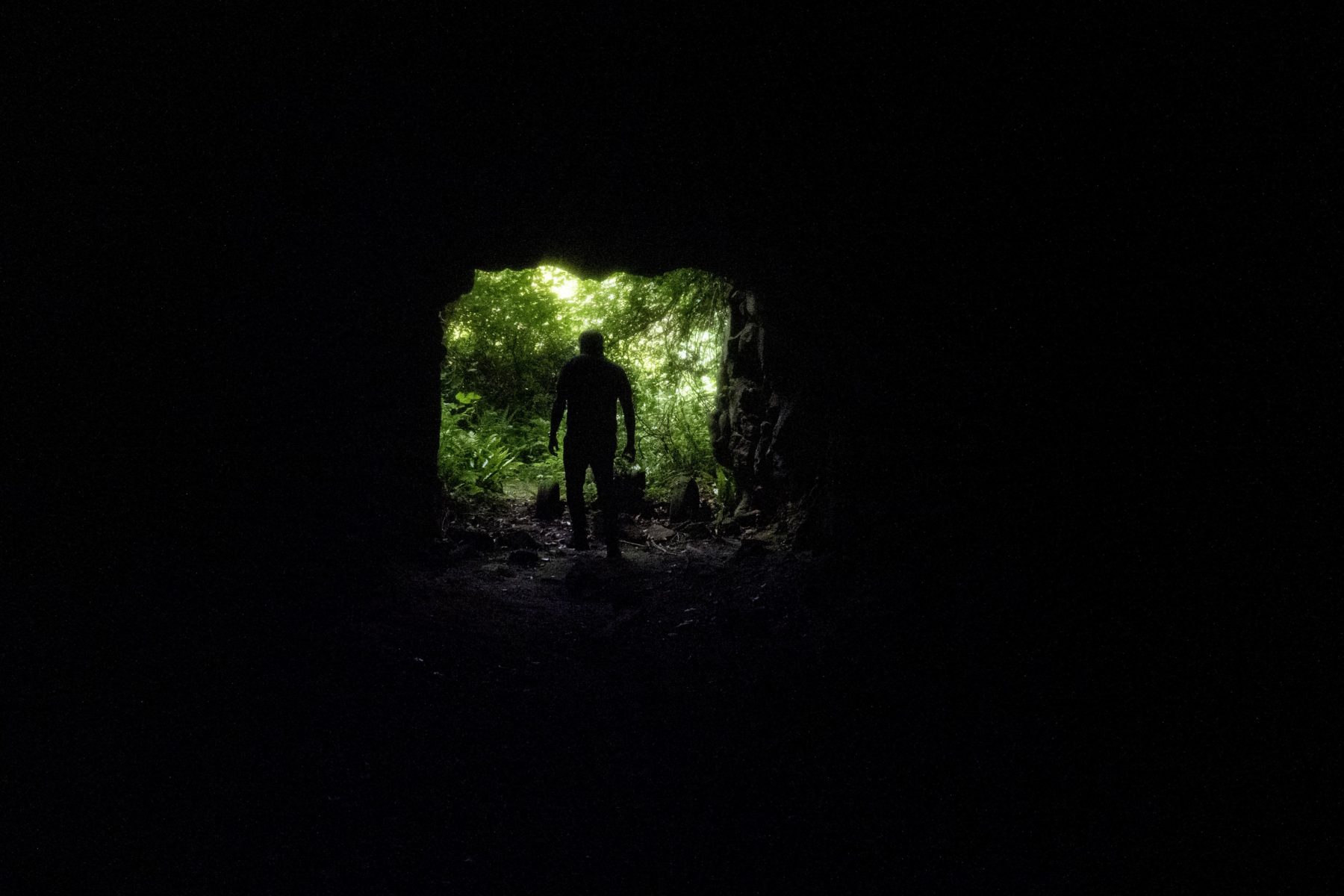
We scramble down on an old rope, pushing aside branches and bracken that grow in front of the entrances.
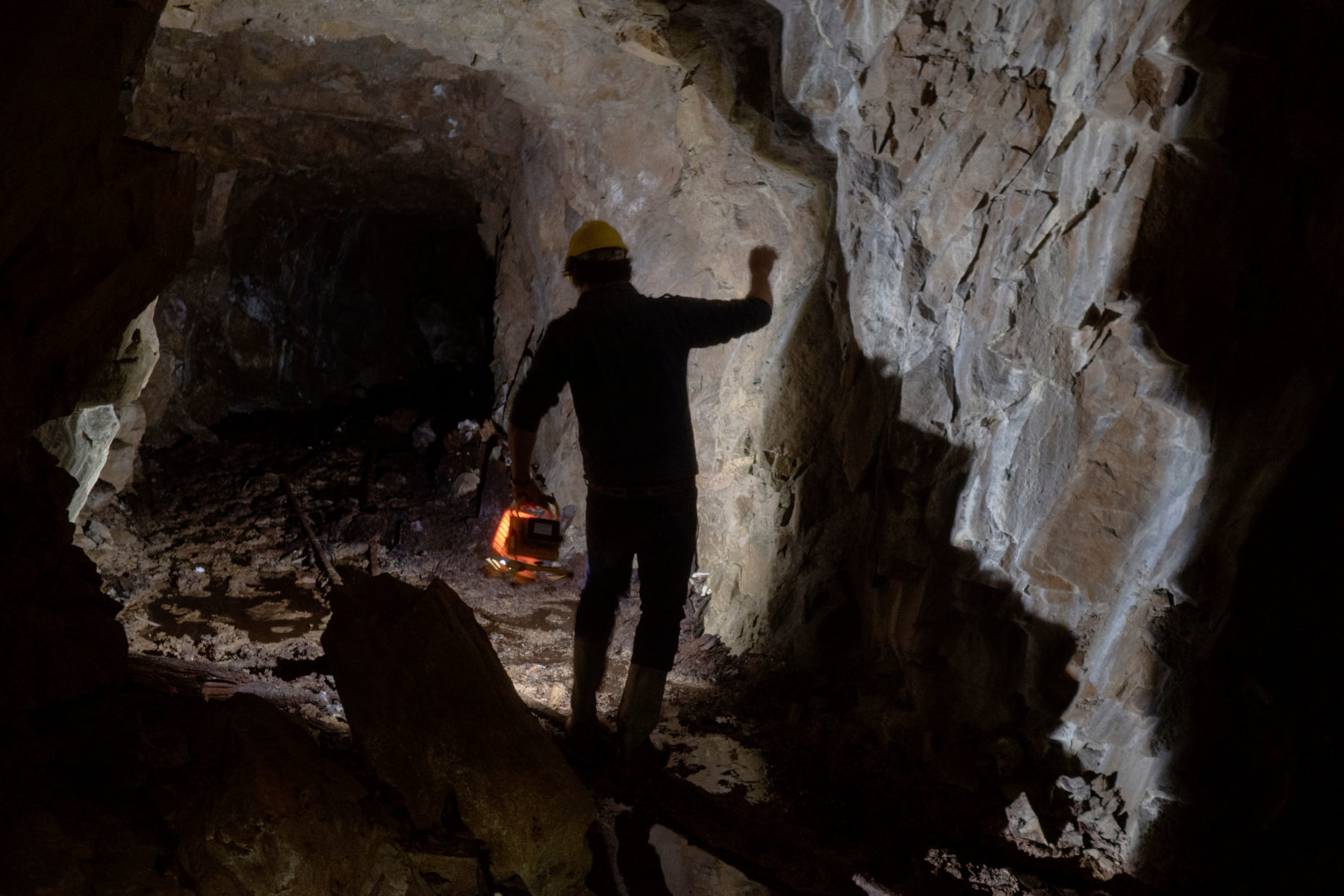
The immense weight of the rock above presses down.
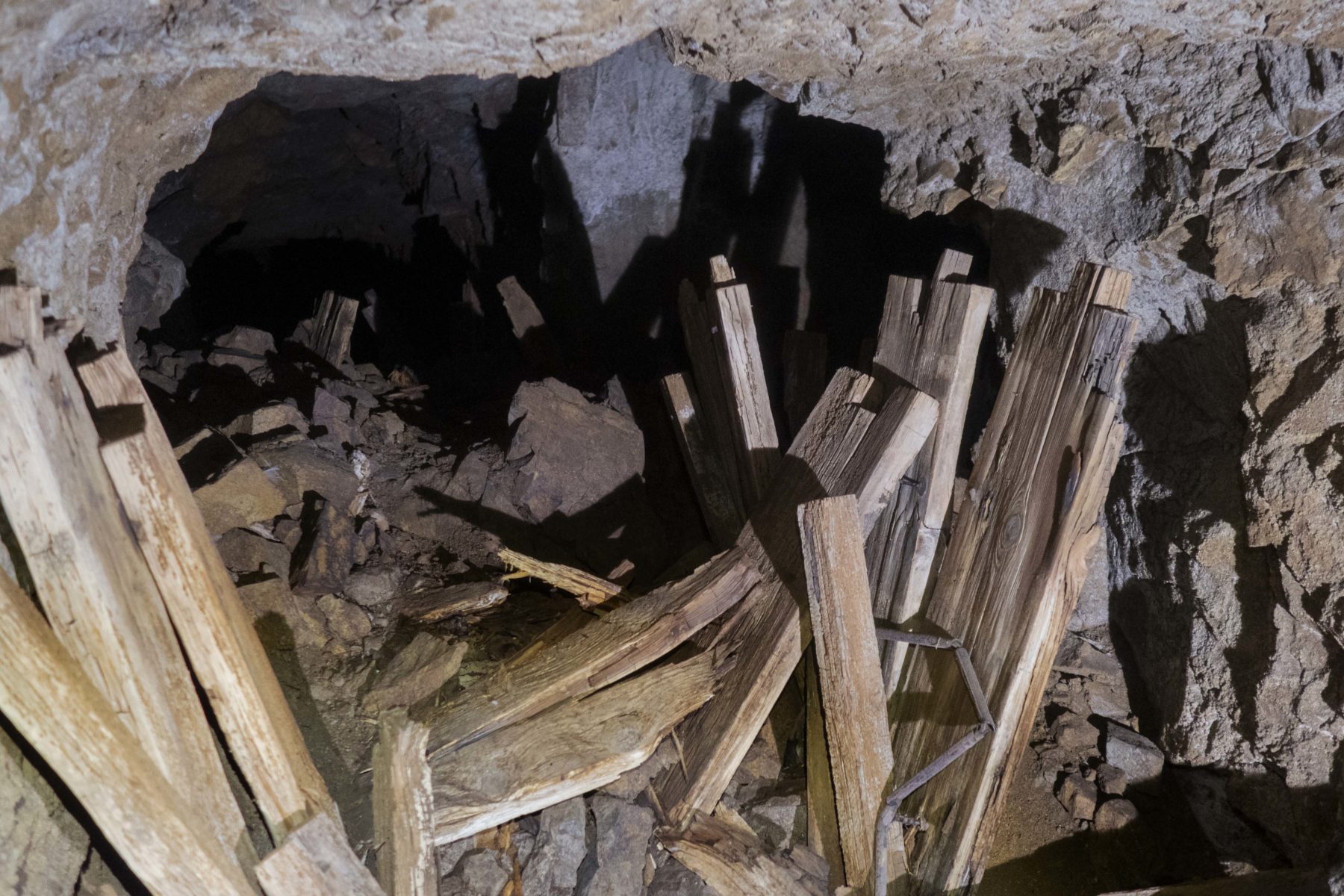
In some places, the tunnels are collapsing.
In others, they’ve been properly finished with cement.

It seems to be telling us “I was here. I existed. I had a life before this.”
Soviet citizens who worked on Alderney were rarely prisoners of war. Marcus Roberts, the Anglo-Jewish heritage historian, described how they were mostly press-ganged or kidnapped civilians and were described by the Germans as “volunteers.”
“You have to ask yourself realistically, what size of labor force would you have needed to complete such constructions?” said Roberts. “I can say with a high degree of certitude that at least 15,000 died there,” he said, describing how it was important to factor in the prisoners’ living conditions, and their ultra-low-calorie diet of thin cabbage soup and bread. “I wouldn't be surprised if that number could be as high as 30,000.”
Professor Caroline Sturdy Colls said her investigations gave her an estimate of between 701 and 986 deaths, but that the true number is undoubtedly higher, due to the Nazis attempts to cover up their crimes.
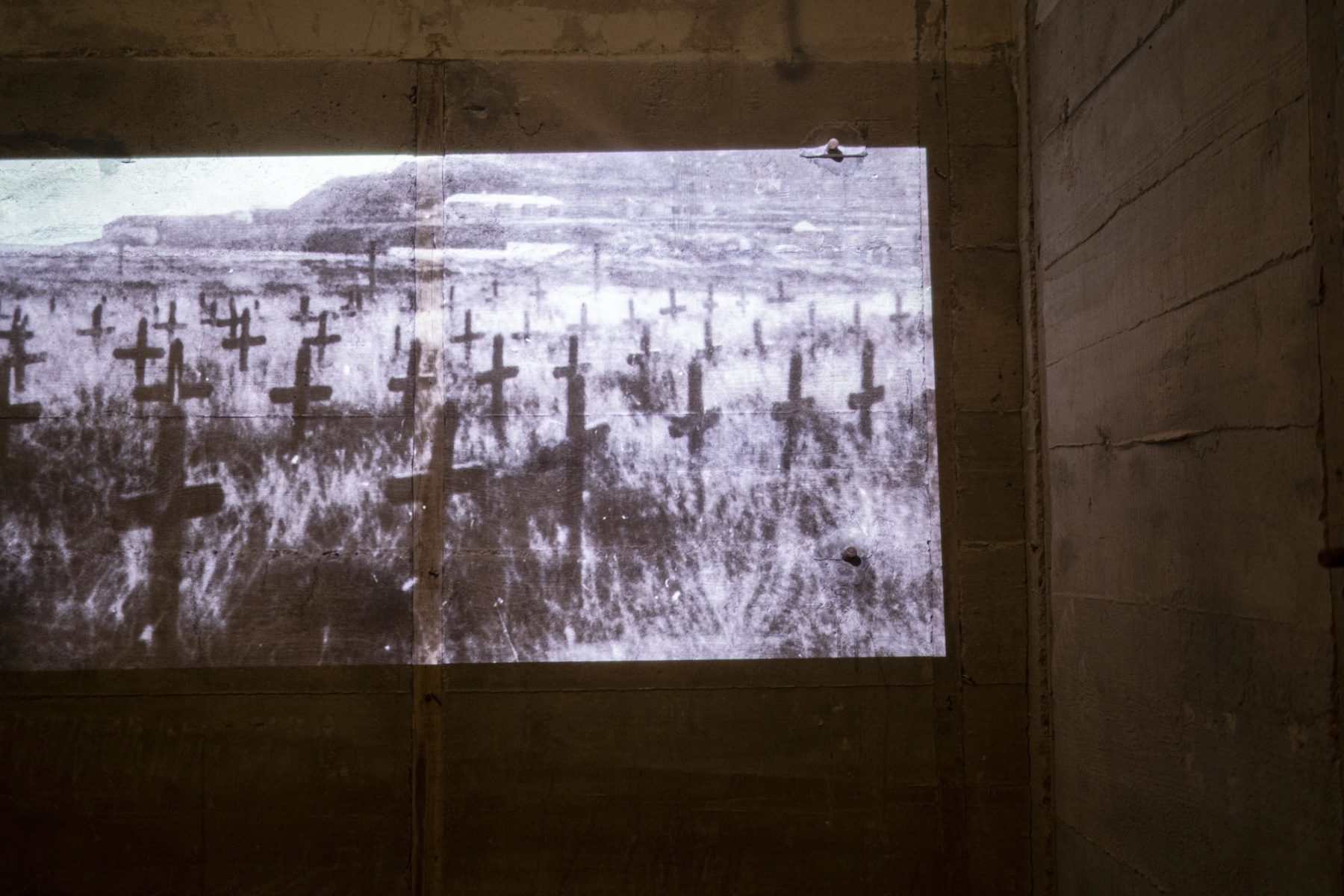
Two military authors, Colonel Richard Kemp and John Weigold, wrote in the Daily Mail newspaper in 2017 that they believed a minimum of 40,000 slave workers died on Alderney — and “perhaps as many as 70,000.” They said Alderney had been turned into “a secret base to launch V1 missiles with chemical warheads on the South Coast.”
These staggering numbers dwarf even the largest estimates made by other historians, causing considerable consternation in Alderney. Trevor Davenport, the director of the Alderney museum, is incensed by the number. “Rubbish! I mean rubbish. I don't even give it any credence at all,” he said.
Davenport does not believe the word “holocaust” pertains to Alderney, and prefers to discuss the island’s wartime past without the mention of forced laborers. He spoke to me on the condition that there would be absolutely no discussion of slave labor. Davenport said the islanders were fed up of listening to “utter tripe” produced by academics parachuting into the island.
The Alderney museum has a single cabinet devoted to the laborers, featuring a sandal worn by the workers along with archival photos. Among the IHRA recommendations described to residents by Lord Pickles, was the suggestion that more be added to the museum’s on-view collection about the island’s prisoners and that a new exhibition should be put together.

In early 2016, two drill rigs arrived on Alderney. One was stationed just off shore. The other was on the fields where forced laborers’ graves are known to be.
The Alderney government had been consulting with a multi-million pound scheme to build an underground electricity link between France, Alderney and Britain, known as the “FAB project.” The cable would span the island of Alderney — and potentially carve right through Longis common, where hundreds of forced labor victims are buried.
Alderney Renewable Energy, the energy developer behind the project, told reporters that the drilling was part of a non-intrusive geophysical survey, intended to “detect any areas of unknown archeology” in the area. Residents said that the Alderney government did not engage with them about the plans, so that when the drills arrived, many didn’t know what they were doing there.
One resident contacted the police on the neighboring island of Guernsey to report that a site of mass murder was being plundered. Britain’s Chief Rabbi, alongside academics and local historians, all aired concerns that mass graves, including those of Holocaust victims, would be disturbed by the project. After being lobbied by one onlooker, the Russian Embassy got involved, issuing a statement saying that any remains of Soviet Citizens found during construction should be identified and given a proper burial. “The Embassy has also offered help with the identification of the said remains,” the statement read.
A group of 32 islanders took legal action, requesting that the British Ministry of Justice conduct a public inquiry. They alleged that the island's government had acted corruptly in its dealings with FAB, and that people within it had a significant conflict of interest in ushering forth the project while standing to financially gain from it. The Guernsey police dismissed the matter, on the grounds that there was insufficient evidence to prove the group’s allegations.
FAB Director James Dickson said FAB had “adhered to the strictest standards of professional conduct” and kept residents extensively informed about the project prior to the rigs arriving, through door-to-door flyers and public meetings.
The States of Alderney chose not to respond to questions about FAB.
Last week, FAB announced that the interconnector was no longer slated to run through Alderney, and would instead bypass the island. “This gives us more certainty, as we need to work with fewer permissions, approvals and licenses,” Dickson said in a statement.
He told me FAB hoped to start construction in 2025.
The drilling was the match that lit the fire. “That’s what brought it all back up for me,” said Michael James, who grew up on the island and has spent the past four years intensively researching Alderney’s past. He described how the FAB project woke many islanders — including him — up to the pressing question of what had really during the war years and how many really lay buried on the island.
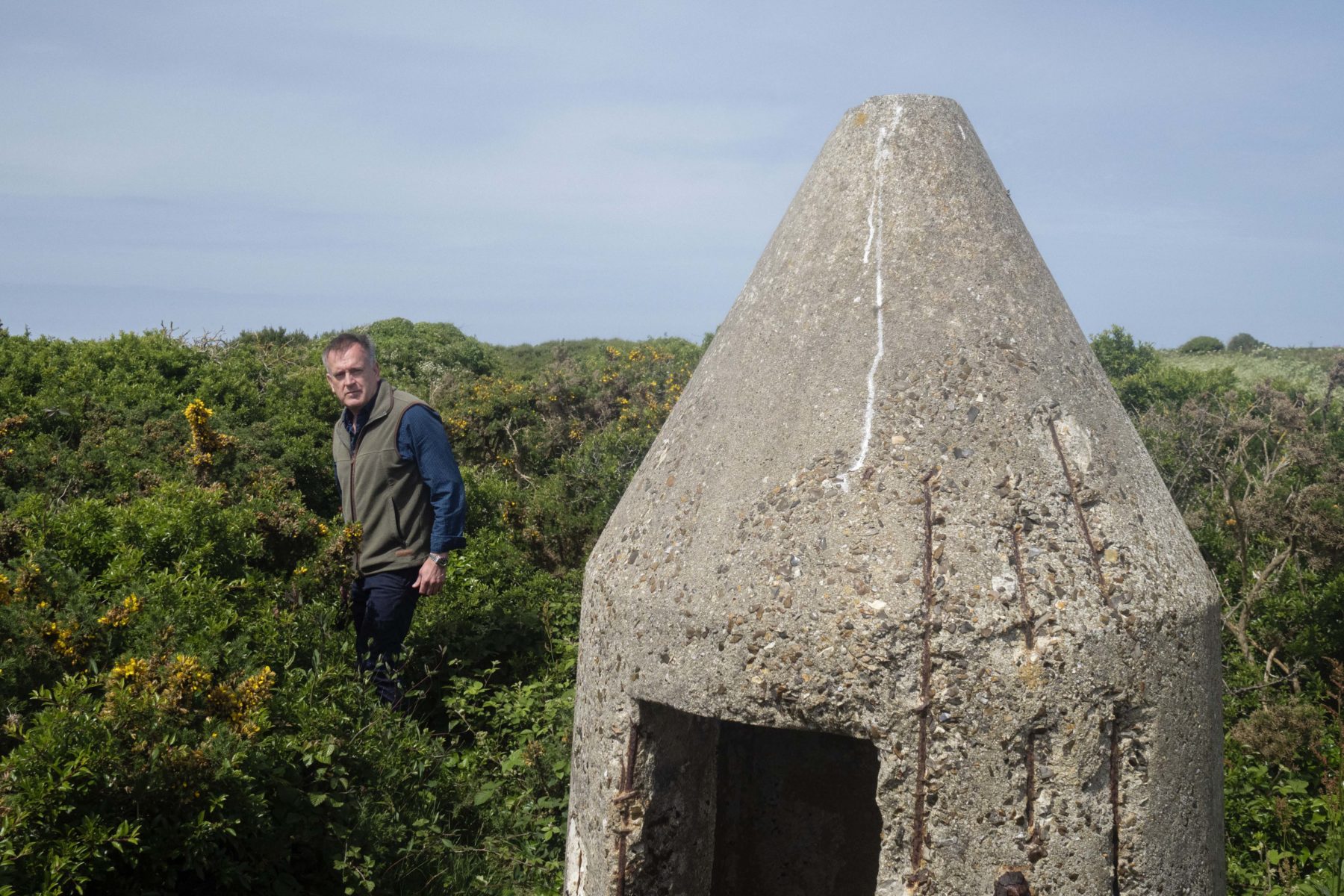
Among those to critique the project at its outset was Professor Caroline Sturdy Colls, who submitted a report about the location of the graves and which areas needed to be avoided. “I voiced my deep, deep concerns that it was going through the site of a former cemetery,” she told me.
The forensic archaeologist’s distinctive, six-syllabled name trips lightly off the tongue of almost every islander I talk to within a matter of minutes. Her work is divisive.
In 2019, Sturdy Colls released a documentary called “Adolf Island.” The film followed her efforts to try to find out precisely how many people were buried in Alderney’s mass graves, using different state-of-the-art, non-invasive techniques, including ground-penetrating radar, laser technology and drones.
Related articles: Battling history
But before the film was made, a leaked pitch for the documentary appeared to show another motive: to dig up Holocaust graves. “Caroline negotiates with the States Council to excavate the site. The evidence is too strong to ignore. It will be an emotional axis for everyone involved in the story,” the pitch read. Marcus Roberts of JTrails wrote to her university that her film constituted the “exploitation of Jewish human remains for commercial gain and public entertainment.” The university chose not to uphold the complaint, according to Roberts.
Sturdy Colls said the pitch had been leaked when the TV production company’s website was hacked and should never have been in the public domain. She called Roberts’s allegations unfair and unfounded. “There was no suggestion that I was ever going to go and dig without any of the permissions being in place,” she said. “My understanding of Jewish law is very thorough.”
When it was released, Sturdy Colls’s documentary dwelt on local opposition to her research. “Shrouded in decades of silence amid attempts by local authorities to prevent examination and the search for missing victims of Nazi atrocities, the team must turn to state-of-the-art technology to get the answers they seek,” read the press release for the film, released on the Smithsonian Channel.
Sturdy Colls encountered vehement opposition from some islanders, even to her non-invasive techniques. “They want to encourage all ghouls, weirdos and anybody with twisted minds to come to Alderney,” wrote one angry resident to the local paper, “to see and worship the wonderful Nazi achievements, so that they can probe with modern gear, excavate slave labor camps, and fly their little spy planes. Well, not if I can help it.”
Sturdy Colls said she has never in her career experienced the hostility she faced in Alderney. “All because they want to forget the memory of people who were brutalized and murdered on this island,” she said in her documentary. At one point, she told me, residents threatened to shoot down her drone equipment.
Nigel Dupont, 63, a lifelong Alderney resident whose family have lived on the island for six generations, does not want to forget. He believes wartime events were “all hushed up” once Britain took back the Channel Islands. We drink tea in his light-filled kitchen, which looks out across Longis Bay. An anti-tank wall the Germans built, known as the “wall of certain death” — where witnesses said they saw bodies thrown into the cement — can be seen in the distance.
“Lots of dark things happened here,” Dupont said, remembering how he grew up in a culture of collective silence. “Local families wouldn’t sit around the table and talk about what happened.”
In the 2000s, that attitude began to change. “As people started to die, there became more pressure to talk,” he said, referring to the passing of the last generation with a living memory of the war.
Dupont said he paid scant attention to the significance of the architecture dotting the island as a young man. He used to throw epic parties in the German bunkers — “the acoustics were fantastic.” But as he got older and became a building contractor, he began to see the architecture of the island differently. “Over the years, the more I’ve read and the older I’ve gotten, I’ve begun to look around and do the math myself,” he said. He described how real Alderney natives — who have lived there a long time — were all keen to understand what really happened during the years they were forced to leave their island home.
“My generation is ready to know the truth.”
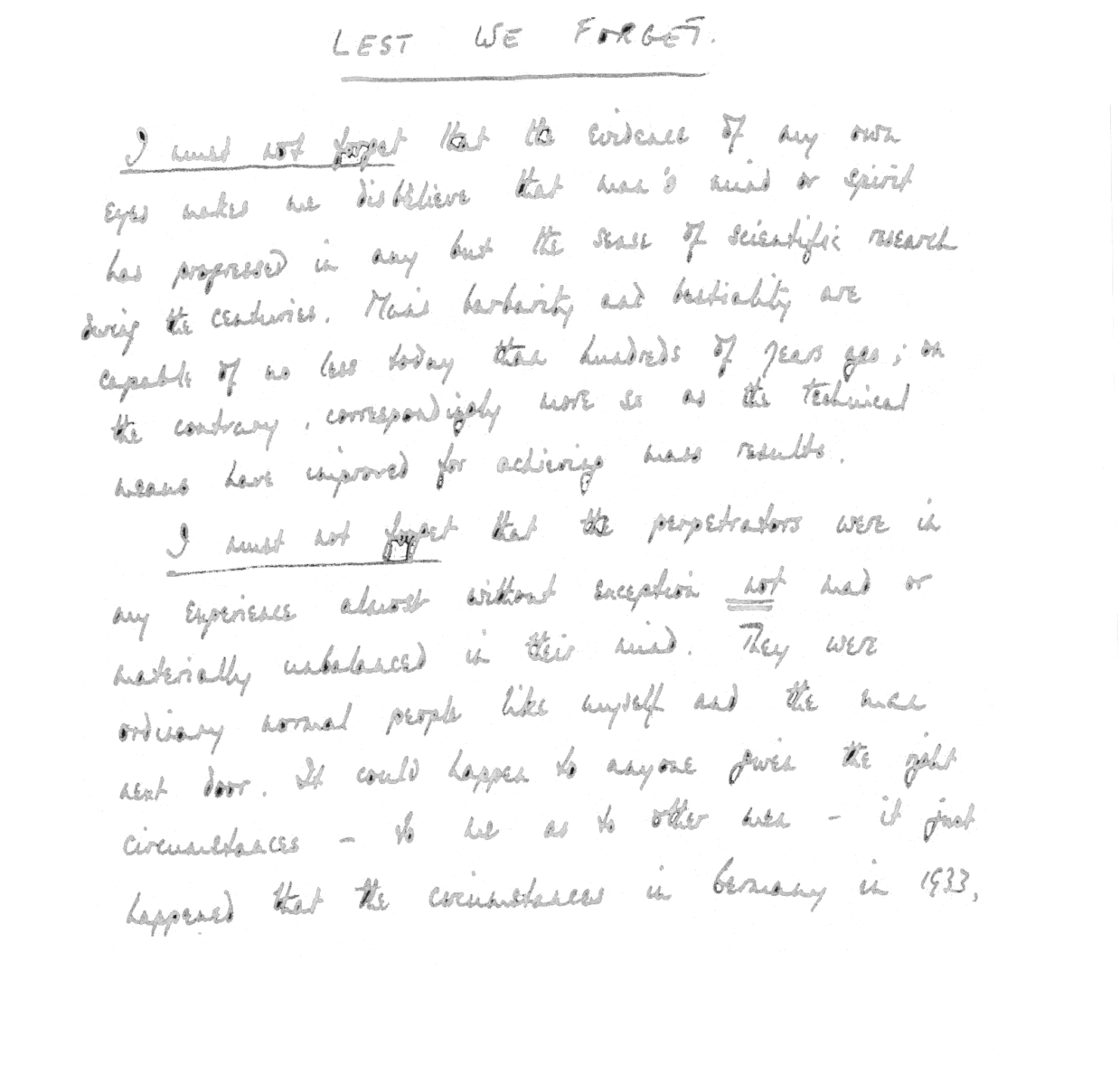
In 1947, two years after he visited Alderney to conduct his investigation into German atrocities, a 26-year-old Captain Theodore “Bunny” Pantcheff wrote a memorandum to himself. It was a list of sentences, written in black fountain pen, each starting with the same four, underlined words: “I must not forget.”
“I must not forget the dead who were murdered,” he wrote. “Nor the face of a corpse that has been maimed and buried alive.”
“Humanity has been and is being outraged; only the few who are whole-heartedly persuaded of that, who know, will be prepared to do anything about it.”
The story you just read is a small piece of a complex and an ever-changing storyline that Coda covers relentlessly and with singular focus. But we can’t do it without your help. Show your support for journalism that stays on the story by becoming a member today. Coda Story is a 501(c)3 U.S. non-profit. Your contribution to Coda Story is tax deductible.
